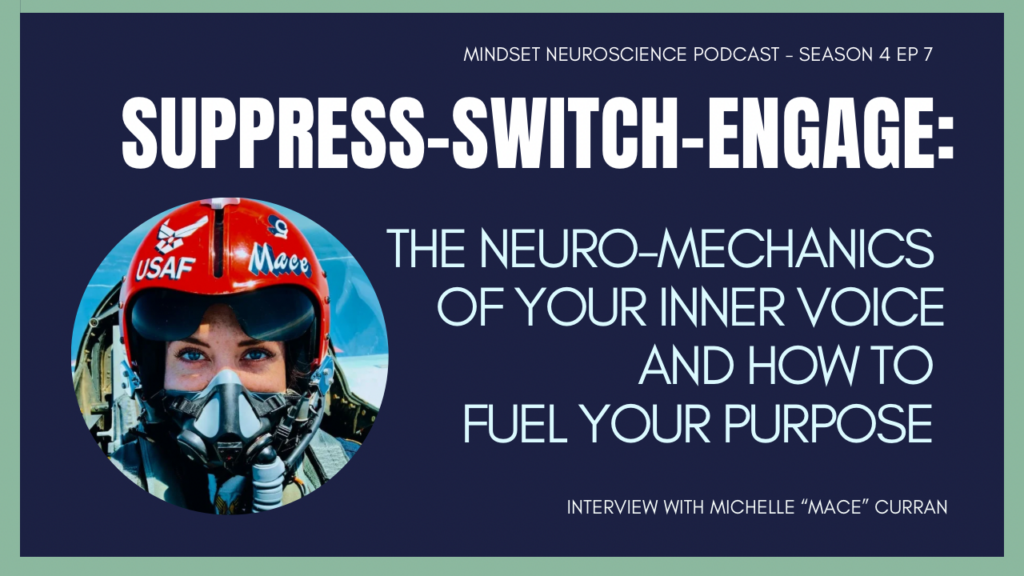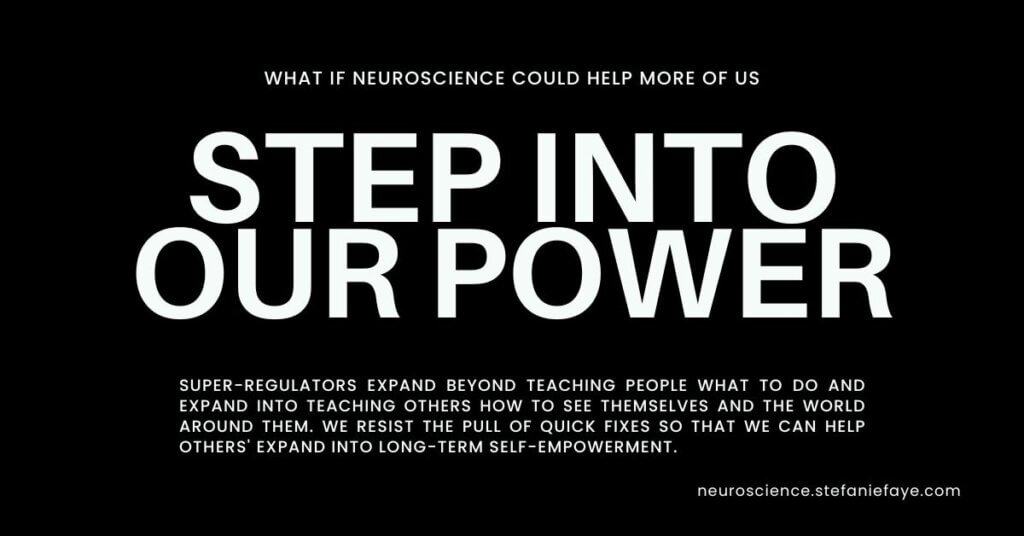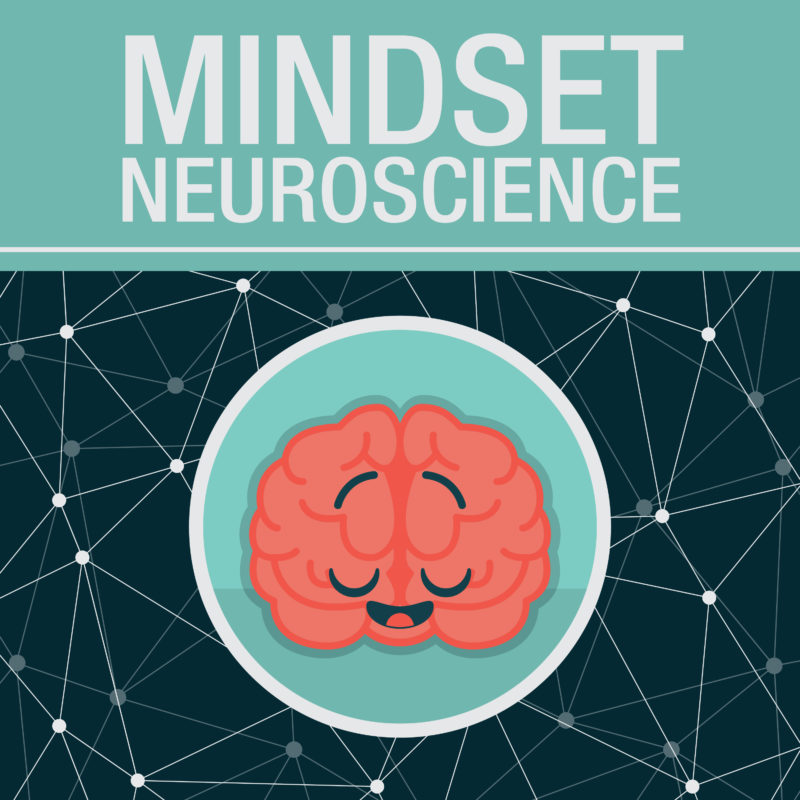
Imagine yourself when you were at a low point in your life. Is there a voice that could have somehow helped you see yourself in a new way? Perhaps an older, wiser version of you.. Or even a younger version of you telling you what your younger self needed to hear as they were growing up?
What about when things are going well, when you achieve some sort of success? What kind of inner voice do you hear? Does it cheer you on, or does it get you doubting that you deserve a win?
In my interview with Michelle “MACE” Curran, we dive into the neural architecture behind the idea of our inner critic, imposter syndrome, and what it means to live life from a place of striving and opening towards what we desire, rather than from a place of fear of rejection and failure.
We talk specifically about how these systems play out in our pursuit of our passions.
Listen to this episode on:

As you think about something you want to improve, achieve, transform… what do you notice about the chatter that goes on inside… does it remind you that you may not be able to pull it off? Or perhaps there’s an image of others looking at you disappointed, indifferent, or amused…
This is a big part of Michelle’s journey, as she dealt with a prolonged period of self-doubt and feeling like she didn’t belong in a community that she had initially joined because of her passion and big dreams.
What would your life be like if that voice or those images boosted you up and fueled you to keep showing up as your highest, most evolved, courageous, alive self?
There are ways we can activate that inner voice to serve us in those ways, fueled by purpose, intention and faith in our ability to adapt and pivot as needed, even when things are uncertain and rocky. Michelle shares how she was able to shift from fearing failure and rejection into a life of pursuing her deepest passions and sharing her most authentic self.
Because here’s the thing...
When we are faced with goals, dreams and ideas about who we would most love to be and what we would love to share with the world, ALL of these have ONE thing in common…
…they carry a level of uncertainty. In terms of evolution and survival, uncertainty ALWAYS carries the potential for danger.
As an energy-conserving system, our brain-body machinery wants to keep us safe.
We’ve all heard that. But what does that mean, exactly?
First, it means that in order to organize our actions and responses to the world, the brain-body needs to ‘triage’ its resources. It can do this by first assessing if something is familiar or unfamiliar. If it's familiar, an efficient way to allocate resources is to avoid what is harmful, move towards what is helpful and not bother with anything that is irrelevant (these are also known as approach/avoid, aversion/appeal and ‘yum’, ‘yuck’ and ‘meh’ appraisals).
When something is unfamiliar, it will also get an added predictive measure: if something is unfamiliar, it is best to first assess it as a potential threat, and either avoid it - or explore it with caution. Once it is deemed as not threatening (and this can only happen with an experience of it not harming us), the brain-body can update its assessment.
Suppress, Switch, Engage
So how do these systems play out? The brain-body uses suppress, switch and engage mechanisms to help us avoid, approach or ignore what is around us (and in our mind in terms of images, thoughts, words).
From an embodied, mechanical perspective, this could look like:
- Feeling the urge to say something to someone, but your mouth and vocal machinery contort into saying something else (switch) or into saying nothing (suppress)
- Having a moment of feeling excited about a new plan for your career or personal life and getting ready to take a new action such as drafting an email, preparing an application or profile (engage), and then feeling doubt come over so you change your mind and don’t press send/submit (suppress)
- Getting ready to take a positive action for your wellbeing like preparing workout clothes, buying healthy groceries (engage) and then getting sidetracked by something else less healthy (switch)
- Wanting to ask for support, but holding yourself back from asking (suppress)
We can’t get rid of our threat-detection architecture and we wouldn’t want to.
It is part of our survival. But what can be helpful is for us to know that the default setting of our threat-detection system is ‘on’ and that what comes next has to do with how you use another system related to your ‘attentional beam’ or spotlight of awareness.
This spotlight can be used for internal and external stimuli. What this spotlight focuses on influences our inner voice and approach/avoidance systems. The human brain is endowed with specialized circuitry that allows us to take control over where we shine this spotlight of awareness.
Here's how to experiment with your spotlight:
- keep your eyes open, looking forward but use your beam/spotlight to think about the last time you smiled
- close your eyes and guide your awareness to your left pinky toe
- close your eyes and guide your awareness to the far corner of the room you're in
- close your eyes and pretend you are looking down at the top of your head from a camera a few feet above you
You can, with your intention, change what your consciousness is focused on. The more you practice this, the stronger your ability is to focus it at will, even during times of challenge and dysregulation.
We can use our spotlight of awareness to shine a light on what to approach, rather than what we are trying to avoid.
We can open up our awareness to take in more inputs and attempt to extract learning and information from whatever we are facing (we talk more about this in length during the episode, including a cool technique that Michelle used as a fighter pilot).
Using our attentional mechanisms in this approach-oriented, exploratory way helps us update the algorithms that tend to restrict our focus onto what is wrong and what will hurt us.
This can include noticing:
- what we are learning from a tough situation
- what skills are we mastering when things are not going as planned
- our micro-wins
- who is grateful for us
- what we have done in the past that has worked well
- our own track records of what we have survived
We can become more intentional about how we use our attentional mechanisms.
The more often we make an intention to notice things that keep us in a more approach-oriented state, the more accessible those networks become in moments of change and uncertainty.

Learn much more about how we can specifically suppress, switch and engage our inner voice to help us expand and reach towards our most vibrant states of being, service and purpose in this fascinating conversation with Michelle.
About Michelle:
Michelle Curran a former United States Air Force (USAF) major and a pilot in the USAF Air Demonstration Squadron, or Thunderbirds. Curran was the lead solo pilot for the Squadron. Curran is the fifth woman to fly with the Thunderbirds, her callsign (or nickname) is "MACE". She now inspires and empowers audiences all over the world with her insights from her training as a fighter pilot and perspectives from navigating challenges and life paths through self-awareness, exploration and pursuit of passion.
References for self-talk and self-appraisal and social support
Brühl, A. B., Rufer, M., Kaffenberger, T., Baur, V., & Herwig, U. (2014). Neural circuits associated with positive and negative self-appraisal. Neuroscience, 265, 48–59. https://doi.org/10.1016/j.neuroscience.2014.01.053
Naomi I. Eisenberger, Shelley E. Taylor, Shelly L. Gable, Clayton J. Hilmert, Matthew D. Lieberman, (2007). Neural pathways link social support to attenuated neuroendocrine stress responses, NeuroImage, Volume 35, Issue 4, 2007, Pages 1601-1612, https://www.sciencedirect.com/science/article/abs/pii/S1053811907000857
What is your vision for the remainder of this year?
As we launch into the later season of the fall, we are entering a renewed energy of expansion. With this comes a need for Way-Showers and Super-Regulators… people who want to bring their highest level of intention and contribution to the world and society…

If there is something stirring inside of you about what you are here to do, and you want to share with the world, you may be interested in joining me for the Super Regulators Neuroscience Academy - a training for coaches, leaders and professionals to deepen their understanding of the neuro- and bio-mechanics of human potential, mindset shifts and nervous system regulation.
Learn more about this HERE.

